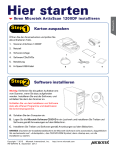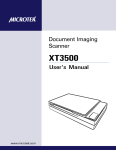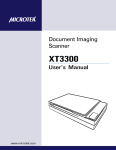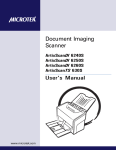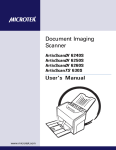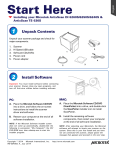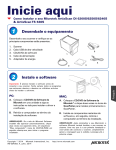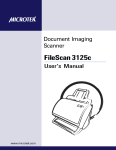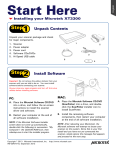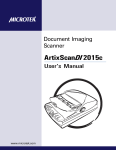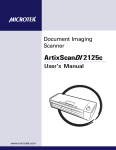Download Microtek ArtixScan1200DF User`s manual
Transcript
Document Imaging Scanner ArtixScan 1200DF User's Manual www.microtek.com Preface Copyright Copyright © 2013, Microtek International, Inc., all rights reserved. This document may not be reproduced or copied in any way, stored electronically, or translated into any language, without the permission of Microtek International, Inc. Trademarks Microtek, ScanMaker, ArtixScan, ScanWizard and ColoRescue are trademarks or registered trademarks of Microtek International, Inc. All other trademarks or registered trademarks are the property of their respective holders. Specifications, software and hardware bundles are subject to change without notice. Not responsible for typographical errors. Disclaimer The contents of this manual have been checked carefully for accuracy, and every effort has been made to ensure that there are no errors. However, Microtek makes no guarantee as to the accuracy of the contents of this document and reserves the right to make changes to the contents without prior warning. I49-004646 B September 2013 Microtek International, Inc. 6, Industry East Road 3, Science Based Industrial Park, Hsinchu, 30077, Taiwan Tel: 886-3-5772155, Fax: 886-3-5772598, http://www.microtek.com 2 ArtixScan 1200DF User's Manual FCC Compliance Statement This equipment (Model: MRS-1200DF) has been tested and found to comply with the limits for a Class B digital device, pursuant to Part 15 of the FCC rules. These limits are designed to provide reasonable protection against harmful interference in a residential installation. This equipment generates, uses and can radiate radio frequency energy and, if not installed and used in accordance with the instructions, may cause harmful interference to radio communications. However, there is no guarantee that interference will not occur in a particular installation. If this equipment does cause harmful interference to radio or television reception, which can be determined by turning the equipment off and on, the user is encouraged to try to correct the interference by one or more of the following measures: • Reorient or relocate the receiving antenna. • Increase the separation between the equipment and receiver. • Connect the equipment into an outlet on a circuit different from that to which the receiver is connected. • Consult the dealer or an experienced radio/TV technician for help. Note: A shielded Hi-Speed USB interface cable with ferrite core installed on the scanner connector end must be used with this equipment. Caution: Changes or modifications not expressly approved by the manufacturer responsible for compliance could void the user's authority to operate the equipment. This device complies with Part 15 of the FCC Rules. Operation is subject to the following two conditions: (1) This device may not cause harmful interference, and (2) this device must accept any interference received, including interference that may cause undesired operation. ArtixScan 1200DF User's Manual 3 Safety Precautions Before using your scanner, read the following safety guides carefully, which detail the proper operation of the scanner and its accessories to prevent injuries or damage to users or equipment. Power Source and AC Power Cord: • Use a power source only with a power rating specified on the marking label. • Insert the plug completely into the outlet, as a loose connection may cause arcing and result in fire. • Place and route the power supply cord such that it is not likely to be walked on or pinched by items placed upon or against them, paying particular attention to the cord near the power plugs, convenience receptacles, and at the point where it exits from the outlet. • When the scanner is left unattended and unused for long periods of time, unplug it from the wall outlet. Moving and Storing the Scanner: • Always lock the scanner when shipping or moving the scanner. Quick stops, excessive force, and uneven surfaces may cause the product to overturn when moving. • When locking or unlocking the scanner back, do not turn the scanner upside down. • Do not place the scanner on any slippery, slanted, or unstable surface. The product may slide or fall, causing serious injury to people as well as serious damage to the product. • Do not use this scanner near water. Never spill liquid of any kinds on the product, or it may result in electric shock or other hazards. • This scanner should be situated away from heat sources such as radiators, heat registers, stoves, or other products (including amplifiers) that produce heat. Service: 4 • When you need a repair service, unplug the scanner from the power outlet and consult qualified service personnel. • When replacement parts are required, use replacement parts that are specified by the manufacturer or have the same characteristics as the original parts. ArtixScan 1200DF User's Manual Table of Contents Preface ............................................................................................... 2 FCC Compliance Statement ................................................................ 3 Safety Precautions ............................................................................. 4 Knowing about Your Scanner .............................................................. 7 Features of the ArtixScan 1200DF .................................................... 7 Installation Requirements .................................................................. 9 Taking a Closer Look ...................................................................... 10 Top/Rear/Side View ................................................................. 10 Front/Open View ..................................................................... 11 Initial Setup ...................................................................................... 12 Following the Four Easy Steps ........................................................ 12 Step 1: Unpacking Package Contents ......................................... 12 Step 2: Installing the Software .................................................. 13 Step 3: Unlocking the Scanner .................................................. 14 Step 4: Connecting the Scanner ................................................ 14 To the ADF ....................................................................... 14 To the Power Adapter ........................................................ 14 To the Hi-Speed USB Cable ................................................ 15 Positioning Documents ................................................................... 16 Into the ADF (Automatic Document Feeder) ...................................... 16 On the Flatbed ............................................................................... 18 Scanning Documents ....................................................................... 19 Using ScanWizard DI ..................................................................... 19 Scanning a Single-sheet Document ............................................ 19 Scanning a Stack of Documents ................................................ 23 Scanning Documents with Mixed Contents ................................. 26 Scanning Documents with Barcodes ........................................... 28 Utilizing Scanned Documents .......................................................... 31 Scanning for Archiving ................................................................... 31 Scanning for OCR .......................................................................... 34 Scanning for PDF ........................................................................... 35 Scanning for E-mail ........................................................................ 36 Scanning for Copying ..................................................................... 37 ArtixScan 1200DF User's Manual 5 Customizing the Function Buttons .................................................. 38 Care and Cleaning ............................................................................ 40 Cleaning the Scanner Glass Surfaces ................................................ 40 Cleaning the Rollers ....................................................................... 41 Maintenance ..................................................................................... 42 Replacing the Rubber Pad ............................................................... 42 Appendix .......................................................................................... 43 Fixing Paper Jams ......................................................................... 43 Troubleshooting ............................................................................ 44 Specifications ................................................................................ 45 6 ArtixScan 1200DF User's Manual Knowing about Your Scanner The ArtixScan 1200DF is a color document scanner with an built-in Automatic Document Feeder (ADF) that can hold up to 50 sheets of papers for the unattended volume scanning. It features 1200 x 2400-dpi optical resolution, and has a throughput run of about 15 pages per minute in color. Features of the ArtixScan 1200DF The ArtixScan 1200DF comes with several important features, including the following: • Included Automatic Document Feeder (ADF) — The high-capacity Automatic Document Feeder (ADF) for the ArtixScan 1200DF holds up to 50 sheets, supporting dimensions from 4.14" x 5.83" (105 mm x 148 mm) to 8.5" x 25" (215.9 mm x 635 mm). • Hi-Speed USB port — Hi-Speed USB is capable of data transfer rates of up to 480MB/sec. Hi-Speed USB is backward compatible with the original USB standard, providing the high/low data transfer rate via the included Hi-Speed USB cable. • Three programmable function buttons — The programmable function buttons on the front panel of the scanner provide you an intuitive and easy way to access scanner functions. • New and Advanced Microtek ScanWizard DI software — All-in-one control panel offers a host of features and image adjustment controls. Supporting the TWAIN driver, ScanWizard DI also features full document scanning tools and on-screen proofing. Its multi-scanning area and preview option allow you to obtain quick scans in the preview window. It comes out several distinguished advantages: – Smart duplex scanning support — With this feature, ScanWizard DI enables simplex scanners to scan both sides of a document in one simple click. It efficiently upgrades your present simplex scanner to a duplex scanner, saving a lot of effort and money. – Paper count — The paper count allows user to keep track of all scan actions from both flatbed and ADF. This feature helps to estimate when you may need to replace the rubber or separation pad, or to apply maintenance and service to your scanner, making the use of your scanner more effectively. – Auto Document Rotation — With this feature, the scanner automatically rotates every saved files in a readable direction based on a specific OCR language selected. – Smart Threshold — This feature enables the software to specify the best level for a threshold used in high-contrast and black-and-white images automatically, improving the clearance and readability of black-and-white documents. ArtixScan 1200DF User's Manual 7 8 – Smart Document Enhancement — With this feature, the scanner automatically brings out and improves readability of text and removes unwanted background color (i.e., green, red, or blue) in/from a document that includes multi image elements. – Barcode Separator — With this feature, you can batch scan documents without starting and stopping each time a new file begins by using barcode numbers on the documents. It saves you huge amounts of time and money to organize, to index and to search files of documents in seconds, enhancing the efficiency and productivity of file management. – Remove Blank Page — With this feature, blank pages are automatically detected and removed by the software when scanning a stack of documents. This function is quite helpful especially when users are scanning double-sided documents and some of the pages only have text on the front side. – Remove Punch Hole — With this feature, the software automatically detects the location of the punch holes on the scanned documents and fills them in white. This function works for most common hole puncher standards. – Save multiple images as a single file : This advanced feature allows user to save multiple scanned images as a single file, depending on the number of the scanned images that are defined for document archival. – Auto-crop and auto-deskew : The auto-crop function automatically detects the size of the original image, crops the full scan frame to fit the image, and removes unwanted black borders. The auto-deskew function automatically corrects distorted images for proper alignment. – Color dropout : Red, green and blue colors can be dropped out to allow for clearer and more accurate forms processing with problematic color documents. ArtixScan 1200DF User's Manual Installation Requirements In order to use your ArtixScan 1200DF, your computer must satisfy the following system requirements: • CD/DVD-ROM drive (for installing software) • Color display with 24-bit color output capability • 512 MB RAM or more (1 GB RAM recommended) • Pentium IV PC or higher with Hi-Speed USB (USB 2.0) port (Core 2 Duo CPU recommended) • 5 GB free disk space or more • Microsoft Windows XP, Vista or 7 ArtixScan 1200DF User's Manual 9 Taking a Closer Look Top/Rear/Side View 10 No. Names of Parts Functions of Parts 1 Tray Flap Used to open the feed tray to load documents. 2 Guide Arm Slides to hold a stack of documents. 3 Document Output Tray Stores a stack of documents which have been scanned. 4 Tray Extender Used to extend the length of the Document Feed Tray. 5 Document Feed Tray Holds the documents to be fed into the ADF (for the high-volume document scanning). 6 Paper Stabilizer Keeps a stack of documents neatly on the Document Feed Tray. 7 ADF Cover The cover of the Automatic Document Feeder. 8 Earlobe Lever Lifts up to open the ADF cover. 9 ADF Connector Connects the ADF to the scanner. 10 Hi-Speed USB Port Connects the Hi-Seed USB (USB 2.0) cable to the computer. 11 Power Connector Connects the scanner to the power adapter. 12 Power Switch Turns the scanner on or off. ArtixScan 1200DF User's Manual Front/Open View F1 F2 F3 No. Names of Parts Functions of Parts 1 ADF (Scan Lid) Automatic Document Feeder. 2 Scan Sensor Area Cover Used to cover the scan sensor and rollers. 3 Glass Surface For flatbed scanning of a single-sheet document. 4 Horizontal Ruler Used to measure the width of a scanned document. 5 Programmable Function Buttons Allows users to customize the buttons to perform their preferred functions via software settings. These buttons are F1, F2, and F3. ArtixScan 1200DF User's Manual 11 Initial Setup Following the Four Easy Steps After unpacking your scanner package, you should see four yellow stickers, which are marked from Step 1 to Step 4 and are placed on your scanner contents. Follow the steps in order for a quick and easy installation process. Step 1: Unpacking Package Contents After unpacking your scanner package, please check for the major components listed below. Power adapter ArtixScan 1200DF scanner Black mat Hi-Speed USB cable 12 ArtixScan 1200DF User's Manual Power cord Software CDs/DVDs Step 2: Installing the Software Important: Do not remove the yellow stickers from your scanner until you are told to do so. You must install all software before connecting your scanner. Always close any open programs and turn off Anti-virus utilities before installing software. 1. Turn on your computer. 2. Place the Microtek Software CD/DVD into a drive. 3. Follow the on-screen instructions to install the driver and software. Note: If the Microtek Software Installer screen does not come up automatically, double-click the following in succession: “My Computer”; the CD/DVD-ROM icon; then cdsetup.exe to start the installer program. 4. To install the software on the Microtek Software CD/DVD, click each software program in the order that it appears on the screen to install, and follow the onscreen instructions. 5. Click EXIT on the Microtek Software Installer screen when all the software has been installed. 6. Restart your computer. Drivers & Software Upgrades After you finish the installation of software, if you found that the installed drivers and software cannot run your product or your computer system properly later, please go to the Microtek Download Service site at ww7.microtek.com.tw/service.php to download and install any updates you may require. For additional information about Microtek products, please visit our website at www.microtek.com. ArtixScan 1200DF User's Manual 13 Step 3: Unlocking the Scanner 1. Remove the yellow “Step 3” sticker from your scanner. 2. When the scanner is powered off, tilt the front right corner of the scanner to see the locking switch at the bottom. 3. Push the locking switch to the position as indicated in the graphic, with the icon on the lock showing as “unlocked”. Unlocked Locked Note: To lock the scanner (for shipping and other purposes), follow the steps below: 1. Turn off the scanner. 2. Tilt the front right corner of the scanner to see the locking switch at the bottom. 3. Push the locking switch to the position as indicated in the graphic, with the icon on the lock showing as “locked”. Step 4: Connecting the Scanner To the ADF Make the Automatic Document Feeder (ADF) is properly installed, with its connector securely connected to the scanner’s 15-pin accessory port. To the Power Adapter 14 1. Remove the yellow “Step 4” sticker from your scanner. 2. Connect the power adapter to the back of the scanner. 3. Plug one end of the power cord into the power adapter, and plug the other end of the power cord into a wall outlet or other power source. ArtixScan 1200DF User's Manual To the Hi-Speed USB Cable 4. Connect one end of the Hi-Speed USB cable to your computer. 5. Connect the other end of the Hi-Speed USB cable to the scanner’s USB port. 6. Turn the the power switch at the back of your scanner to “On”, and wait for the light to stop blinking and stay on steady. On Off The system will detect your scanner automatically. Note: It takes a while for your scanner to warm up. Please do not turn the scanner off when it is in the warming-up process; otherwise, it may cause serious damage to your scanner. Power switch ArtixScan 1200DF User's Manual 15 Positioning Documents Into the ADF (Automatic Document Feeder) This section shows you how to position a single-sheet document, as well as a stack of documents, into the ADF (Automatic Document Feeder). 1. Raise the Scanner Lid, and remove the ADF's protective film from the cover of the scan area. Close the lid. Protective Film 2. Pull out the top Tray Extender for better paper support if the length of the originals exceeds 10 inches. Document Feed Tray Tray Extender Document Output Tray 16 ArtixScan 1200DF User's Manual 3. Open the top Tray Flap and load the stack of originals on to the Document Feed Tray, with the side to be scanned facing up. Push the stack of papers into the tray, until the paper's edges touch the feeder rollers. Tray Flap 4. Align the material with the center of the Document Feed Tray by sliding the two Guide Arms toward the stacked sheets if the width of the originals is less than 8.5 inches. Guide Arms Note: There are several precautions and reminders about using the ADF correctly. Please refer to the section as below for the detail. • The document feeder is not designed for scanning photos; doing so may damage your originals. Microtek accepts no responsibility for damage that may arise from misuse of equipment. • The ADF can handle documents of the following paper sizes: – Dimensions: Min. 4.14" x 5.83" (105 mm x 148 mm) Max. 8.5" x 25" (215.9 mm x 635 mm) – Thickness: 10 to 30 lbs. – Document Feed: 50 sheets maximum of copy bond paper • If the documents are torn, curled, or wrinkled, do not put them into the ADF to scan, because they may cause paper jams. • Remove paper clips or staples before placing documents into the ADF. DO NOT use the ADF to scan documents with paper clips or staples because they may cause paper jams or damage the scanner. ArtixScan 1200DF User's Manual 17 On the Flatbed This section shows you how to position a single-sheet document, such as a single photograph or a page from a book, on the flatbed: 1. Raise the scanner lid, and place the document to be scanned face down on the scanner glass surface. Place the top end of the document towards the front of the scanner. 2. Place the black mat that came with your scanner on top of the photo, then lower the scanner lid on the scanner glass surface. Note: Use of the black mat on top of your photo filters out unwanted light during scanning, and ensures the correct functioning of the automatic cropping feature when you do a preview scan. With the document face down on the scanning glass, align the document against the Horizontal Ruler of the scanner. 18 ArtixScan 1200DF User's Manual Scanning Documents Using ScanWizard DI ScanWizard DI is a scanning software designed by Microtek for document scanning in color, black and white, and grayscale in both duplex and simplex modes. Its user-friendly interface enables you to easily start the scanning process. Refer to the ScanWizard DI software manual for more details. Warning: • Do not place photos or fragile materials in the feed tray, for it will damage the originals when performing the feeding process. Always place frail originals on the scanner's glass surface and choose “Flatbed” as your Scan Source. • Before scanning the document from the ADF, make sure the flatbed scanning area is clear from any obstructions. Otherwise, a scanning error may occur. The following sections will show you step by step how to use ScanWizard DI. Scanning a Single-sheet Document 1. Place the single-sheet document to be scanned on either the scanner glass surface or on the ADF’s Document Feed Tray. 2. Launch ScanWizard DI (either as a stand-alone by clicking the program icon, or by using the “File-Import” or “Scan” command from an application program). 3. Specify your scanning requirements in the ScanWizard DI control panel. a) b) Select your image input device in the Scan Source drop-down menu. – Select Flatbed if you place the document on the scanner’s glass surface. – Select ADF (Simplex) to scan a document if the document is fed from the ADF’s Document Feed Tray. Select your image output type in the Scan Type drop-down menu. – Select RGB Color (24 bits) to scan the image in color. – Select Grayscale (8 bits) to scan the image in grayscale. – Select Black & White (1 bit) to scan the image in black-and-white. ArtixScan 1200DF User's Manual 19 c) Select a dimension in the Paper Size drop-down menu as your preview image size. d) Select your desired image output resolution in the Resolution drop-down menu. e) If “Auto-crop & Auto-deskew” is selected, the scanner automatically detects the size of the original image, crops the full scan frame to fit the image, and removes unwanted black borders after the scan, as well as corrects the distorted image for proper alignment. 4. If necessary, check “Auto Document Rotation”, “Smart Document Enhancement”, “Remove Blank Page” or “Remove Punch Hole” to enhance the quality of the scanned images. 5. Click the Preview button to perform a preliminary view of the entire image. When done, a preview image appears in the preview window. 6. Click the Scan Frame tool button to adjust the size of the scan frame (enclosed within the red dotted lines and labeled with the tag “Main”). Drag on the edge or corner of the scan frame to resize the scan frame. 7. Select your image type in the Attribute drop-down menu. – Select Line Art to scan line art images (images in one color or in blackand-white, such as logos or mechanical blueprints). – Select Photo to scan color prints. – Select Text to scan text. 8. If necessary, adjust image quality by using the image correction tools. 9. Click the Scan or Scan To button. A pop-up window appears, asking about whether you want to perform smart duplex scanning function. • If you want to scan one side of the document only through the ADF, click the “Simplex Scan” button and follow the steps below: A “Scan To: Save As” dialog box appears. Specify your requirements, then press the Save button. The scanner will start the scanning process. 20 ArtixScan 1200DF User's Manual • If you want to scan both sides of the document through the ADF, click the “Software Duplex Scan” button and follow the steps below: a) A “Scan To: Save As” dialog box appears. Specify your requirements, then press the Save button to start scanning one side of the document. b) When done, a window will appear to remind you to turn over the document. c) Turn over and reload your document. When done, press the Continue button to start scanning the other side of the documents. If ScanWizard DI is launched as a Plug-In from an image-editing program, the scanned image is delivered after the scan to your application, where the image can be saved, printed, or modified further. If ScanWizard DI is launched as a stand-alone program, the scanned image can be saved after the scan to a file, opened in an image-editing program, or sent to a printer. ArtixScan 1200DF User's Manual 21 Scanning settings Scan frame (enclosed by dotted lines and labeled with the tag “Main”) Preview image (the enclosed frame bordered in red) Image type Image correction settings 22 ArtixScan 1200DF User's Manual Preview window Scanning a Stack of Documents 1. Place the stack of documents to be scanned on the ADF's Document Feed Tray. 2. Launch ScanWizard DI (either as a stand-alone by clicking the program icon, or by using the “File-Import” or “Scan” command from an application program). 3. Select ADF (Simplex) as your image input device in the Scan Source dropdown menu. 4. Follow the procedures (steps 3b through 3e) for “Scanning a Single-sheet Document" to specify the rests of scanning requirements in the ScanWizard DI control panel. a) Select your image output type in the Scan Type drop-down menu. b) Select a dimension in the Paper Size drop-down menu as your preview image size. c) Select your desired image output resolution in the Resolution drop-down menu. d) If “Auto-crop & Auto-deskew” is selected, the scanner automatically detects the size of the original image, crops the full scan frame to fit the image, and removes unwanted black borders after the scan, as well as corrects the distorted image for proper alignment. 5. If necessary, check “Auto Document Rotation”, “Smart Document Enhancement”, “Remove Blank Page” or “Remove Punch Hole” to enhance the quality of the scanned images. 6. Select the your image type in the Attribute drop-down menu. 7. If necessary, adjust image quality by using the image correction tools. 8. Click the Scan or Scan To button. A pop-up window appears, asking about whether you want to perform smart duplex scanning function. ArtixScan 1200DF User's Manual 23 • If you want to scan one side of the documents only through the ADF, click the “Simplex Scan” button and follow the steps below: A “Scan To: Save As” dialog box appears. Specify your requirements, then press the Save button. The scanner will start the scanning process. • If you want to scan both sides of the documents through the ADF, click the “Software Duplex Scan” button and follow the steps below: a) A “Scan To: Save As” dialog box appears. Specify your requirements, then press the Save button to start scanning one side of the document. b) When done, a window will appear to remind you to turn over the documents. c) Turn over and reload your document. When done, press the Continue button to start scanning the other sides of the documents. If ScanWizard DI is launched as a plug-in from an image-editing program, the scanned image is delivered after the scan to your application, where the image can be saved, printed, or modified further. If ScanWizard DI is launched as a stand-alone program, the scanned image can be saved after the scan to a file, opened in an image-editing program, or sent to a printer. 24 ArtixScan 1200DF User's Manual For preview purposes only Scan frame (enclosed by dotted lines and labeled with the tag “Main”) Scanning settings Image type Preview image (the enclosed frame bordered in red) Preview window Image correction settings For preview purposes only, take note of the additional notes below: 1. Load a piece of paper from the paper stack into the ADF’s Document Feed Tray as step 1. Do not load more than one sheet, as a single sheet is sufficient for previewing. 2. After finishing step 4 and before proceeding to step 5, click the Preview button to perform a preliminary view of the entire image. When done, a preview image appears in the preview window. At this moment, the previewed page is delivered to the document tray from the ADF's Document Feed tray. Load the previewed page, along with the paper stack, on the ADF's Document Feed Tray. You are now ready to scan. ArtixScan 1200DF User's Manual 25 Scanning Documents with Mixed Contents Many documents contain mixed content with both text and pictures on the same page. You can use a function named "Multiple Scan Frames" to scan different types of documents at the same time. 1. Place the single-sheet color print to be scanned on either the scanner glass surface or on the ADF’s Document Feed Tray. 2. Launch ScanWizard DI (either as a stand-alone by clicking the program icon, or by using the “File-Import” or “Scan” command from an application program). 3. Follow the procedures (steps 3a through 3e) for “Scanning a Single-sheet Document” to specify your scanning requirements in the ScanWizard DI control panel. 4. If necessary, check “Auto Document Rotation”, “Smart Document Enhancement”, “Remove Blank Page” or “Remove Punch Hole” to enhance the quality of the scanned images. 5. Click the Preview button to perform a preliminary view of the entire image. When done, a preview image appears in the preview window. 6. Click the Scan Frame tool button to adjust the size of the scan frame (enclosed within the dotted lines and labeled with the tag “Main”). Drag on the edge or corner to resize the scan frame. 7. Select Photo in the Attribute drop-down menu as your image type for the main scan frame. 8. If necessary, adjust image quality by using the image correction tools. 9. Specify the first subframe. a) Click the Create Subframe tool button. Move the mouse pointer to the text area, then drag to create a rectangle and enclose the text area. b) Select Text in the Attribute drop-down menu as your image type for the selected scan frame. c) If necessary, adjust image quality by using the image correction tools. 10. Specify the second subframe. a) Click the Create Subframe tool button. Move the mouse pointer to the drawing picture area, then drag to create a rectangle and enclose the picture area. b) Select Line Art in the Attribute drop-down menu as your image type for the selected scan frame. c) If necessary, adjust image quality by using the image correction tools. 11. Click the Scan or Scan To button to start scanning. 26 ArtixScan 1200DF User's Manual • If ScanWizard DI is launched as a plug-In from an image-editing program, the scanned image is delivered after the scan to your application, where the image can be saved, printed, or modified further. • If ScanWizard DI is launched as a stand-alone program, the scanned image can be saved after the scan to a file, opened in an image-editing program, or sent to a printer. Create Subframe tool* Scan frame (enclosed by dotted lines and labeled with the tag “Main”) Scanning settings Preview image (the enclosed frame bordered in red) Image type Image correction settings First subframe Second subframe *Create Subframe tool The Create Subframe tool lets you create a new scan frame within the enclosed scan frame that is labeled with the tag “Main”. When a new scan frame is generated, the enclosed scan frame is selected in red dotted lines. The newly added subframe is automatically labeled in series (with tag “1”, “2”, etc.). ArtixScan 1200DF User's Manual 27 Scanning Documents with Barcodes Some documents have barcode numbers on them. You can use a function named "Barcode Separator" to scan documents to be filed with barcode numbers. 1. Load the documents with a barcode on to be scanned into the Document Feed Tray. 2. Launch ScanWizard DI as a stand-alone by clicking on the program icon on the desktop. 3. Follow the procedures (steps 3a through 3e) for “Scanning a Single-sheet Document” to specify your scanning requirements in the ScanWizard DI control panel. 4. If necessary, check “Auto Document Rotation”, "“Smart Document Enhancement”, “Remove Blank Page” or “Remove Punch Hole” to enhance the quality of the scanned images. 5. Click the Preview button to perform a preliminary view of the entire image. When done, a preview image appears in the preview window. 6. Click the Select Frame tool button to adjust the size of the scan frame (enclosed within the red dotted lines and labeled with the tag “Main”). Drag on the edge or corner to determine the final size of the actual scan. 7. Select the your image type in the Attribute drop-down menu. 8. If necessary, adjust image quality using the image correction tools. 9. Check the “Barcode Separator” option to activate the Barcode Frame tool button. 10. Click the Barcode Frame tool button to adjust the size of the barcode frame (enclosed within the red dotted lines and labeled with the tag “BarCode”). Drag on the edge or corner to determine the final size of the actual scan for the barcode. If you have more than one page with a barcode on, make sure if the selected area of the barcode frame covers enough space. If not, when it performs a scan job, your scanner will not detect the barcode which appears outside the selected area of the barcode frame. 11. Reload the document, and then click the Scan To button to start scanning. If the “Save Barcode as Directory” is checked, the program will recognize and use the barcode on the scanned document to generate a file directory, where the scanned document will appear with any predefined prefix and/or serial number. 28 ArtixScan 1200DF User's Manual If the “Save Barcode as Directory” is unchecked, the program will recognize and use the barcode on the scanned document to name the scanned document. You can append any predefined prefix and/or serial number to the output filename in order to differentiate the documents containing same barcode. Barcode number is used as a file directory name Barcode number is used as a file name ArtixScan 1200DF User's Manual 29 Select Frame tool Scan frame (enclosed by dotted lines and labeled with the tag “Main”) Scanning settings Image type Barcode Frame tool Image correction settings Barcode Separator Barcode frame (enclosed by dotted lines and labeled with the tag “BarCode”) 30 ArtixScan 1200DF User's Manual Utilizing Scanned Documents Depending on your needs, you may save your scanned documents into the following several ways: Scanning for Archiving The archiving function allows the scanner to scan documents for recording purposes. For instance, an image “record” can be kept of multiple-page legal documents or of other important documents, such as birth certificates and tax records. 1. Place the documents to be scanned on the ADF's Document Feed Tray. 2. Launch ScanWizard DI in stand-alone mode by clicking the program icon on the desktop. 3. Follow the procedures (steps 3 through 5) for “Scanning a Stack of Documents” to specify your scanning requirements. 4. Click the Scan To button. A pop-up window appears, click either “Simplex Scan” or “Software Duplex Scan” in the window for your scan job. • Click the “Simplex Scan” button to open the “Scan To: Save As” dialog box for the simplex scan function. In the “Scan To: Save As” dialog box, specify the following settings: a) Key in your preferred file name in the “File prefix” edit box, or use the default “Image” as a root file name. b) Select your required export file format. Save the file as TIF, PDF, or DCX, which enables the “Save multiple images as a single file” option in the next step. ArtixScan 1200DF User's Manual 31 c) Check the Auto filename option if you want use the default system file name and number. Or, you can leave the option blank and the Auto filename will be disabled d) Check the “Save multiple images as a single file” option to store all the scanned images as a single file if desired. If you scan the documents through the ADF and enable “Save multiple images as a single file”, you are allowed to specify how many images you would like to be saved in a single file after scan. Check the “Every %image(s) into a file “ option, and then enter your desired number in the edit box directly or click the up/down arrow to increase/decrease the number. The range is from 2 to 100 images. • Click the “Software Duplex Scan” button to open the “Scan To: Save As” dialog box for the smart duplex scan function. Follow the procedures (steps 4a through 4d) for simplex scanning above to specify your requirements. 6. Click the Save button. The originals are sequentially scanned until the stack of documents is depleted; when finished, all the scanned images are saved as a single file. 32 ArtixScan 1200DF User's Manual When the Barcode Separator function is checked, the “Scan To: Save As” dialog box should look like the one as shown below. The “Auto filename” option will be replaced by the “Save Barcode as Directory”. Save Barcode as Directory: If “Save Barcode as Directory” is checked, the value of the scanned barcode is saved and used as a file directory. If unchecked, the value of the scanned barcode is saved and used as a file’s name. When “Save Barcode as Directory” is checked, you have to assign at least one of the “File Prefix” or ”Serial No.” to be your output filename. They cannot be null at the same time. If “Save Barcode as Directory ”is unchecked and if you do not assign either one of the “File Prefix” or “Serial No.” to be a file’s name, the new saved file will overwrite the old one. Note: No matter if you check “Save Barcode as Directory” or not, it is strongly recommended to check “Serial No.” in order to add it as part in your file’s name. For if you do so, the system will automatically generate a sequential number based on when the file is saved. Otherwise, if you do not do so, when you scan another document with the same barcode value as that on the old one and you forget to name it in different file prefix, the new scanned document will overwrite the old one immediately. ArtixScan 1200DF User's Manual 33 Scanning for OCR The OCR (Optical Character Recognition) function allows the scanner to convert a scanned document into text that can be edited from any word processing application. 1. Place the documents with text to be scanned on the ADF's Document Feed Tray. 2. Launch ScanWizard DI in stand-alone mode by clicking the program icon on the desktop. 3. Follow the procedures (steps 3 through 6) for “Scanning a Stack of Documents” to specify your scanning requirements 4. a) In step 4d, the recommended resolution is 300 dpi or above for OCR. b) In step 5, from the Attribute options menu, choose Line Art as your image type to obtain best OCR results. When Black & White is your chosen mode in the Scan Type options, Line Art should be the selected image type. Click the Scan To button and hold down the mouse until the options menu appears, then select OCR to open the “OCR” dialog box. In the “OCR: Save As” dialog box, specify the following settings: 5. a) Key in your preferred file name in the “File prefix” edit box, or use the default “Document” as a root file name. b) Select your required export file format. c) Check the “Save multiple pages as a single file” option to store all the scanned images as a single file if desired. d) Select your preferred language from the “OCR Language” options. The available options are English, German, French, Italian, Spanish, and Chinese. e) Check the “Send document to application after saving” option, then choose your word processing application from the options. Click the Save button. The originals are sequentially scanned until the stack of documents is depleted; when finished, all the scanned images are saved as a single file. The saved file can now be opened from your chosen application and is ready to be edited. 34 ArtixScan 1200DF User's Manual Scanning for PDF The scanner can easily convert any paper document into an image and saves it as an Adobe Portable Document Format (PDF) file for viewing with the Adobe application software. It also offers variable compression levels for full controls over file sizes and image quality. 1. Place the documents to be scanned on the ADF's Document Feed Tray. 2. Launch ScanWizard DI in stand-alone mode by clicking the program icon on the desktop. 3. Follow the procedures (steps 3 through 6) for “Scanning a Stack of Documents” to specify your scanning requirements 4. Click the Scan To button to open the “Scan To: Save As” dialog box. In the “Scan To: Save As” dialog box, specify the following settings: a) Key in your preferred file name in the “File name” edit box, or use the default “Image” as a root file name. b) Select “Portable Document Format” as your file-saving format from the “Save as type” drop-down menu. c) Check the “Save multiple images as a single file” option to store all the scanned images as a single file if desired. Specify the number of the scanned images that you would like to be saved in a single file. d) 5. Check the “Send image to application after saving” option, then choose your Adobe application software from the options. Click the Save button. The originals are sequentially scanned until the stack of documents is depleted; when finished, all the scanned images are saved as a single file. The saved file can now be opened from your chosen application and is ready to be viewed. The File Option button is active when the “RGB Color” or “Grayscale” is set as your image output type and the PDF is chosen. With this function, you can control the image quality compression as your desired. Note: The scanner also allows you to scan a text document and convert it to an editable PDF file for editing with the Adobe Acrobat writer. Follow the procedures for “Scanning for OCR”, in step 4b, select the “Portable Document Format” as your file-saving format. ArtixScan 1200DF User's Manual 35 Scanning for E-mail The e-mail function allows the scanner to save and send the scanned images to your preferred e-mail application program in one simple step. This lets you share your scanning results with others fast and easily. 1. Load the documents to be scanned into the Document Feed Tray. 2. Launch ScanWizard DI in stand-alone mode by clicking the program icon on the desktop. 3. Follow the procedures (steps 3 through 7) for “Scanning a Stack of Documents” to specify your scanning requirements. 4. Click the Scan To button and hold down the mouse until the Options menu appears, then select E-mail to open the “Email: Save As” dialog box. In the “Email: Save As” dialog box, specify the following settings: 5. a) Key in your preferred file name in the “File name” edit box, or use the default “Image” as a root file name. b) Select your required export file format. c) Check the “Save multiple images as a single file” option to store all the scanned images as a single file if desired. d) If the “Send image to application after saving” option is checked, the scanner will send your scanned and saved image file to the e-mail application program assigned in the system. Click the Save button. The File Option button is active when the The originals are sequentially “RGB Color” or “Grayscale” is set as your scanned until the stack of image output type and the PDF is chosen. With this function, you can control the image documents is depleted; when quality compression as your desired. finished, all the scanned images are saved as a single file. The saved file can now be sent from your chosen e-mail application to others and is ready to be viewed. 36 ArtixScan 1200DF User's Manual Scanning for Copying The copy function allows the scanner to work like a copier using your printer, with documents printed successively without interruption. This lets you transform your scanner and printer into a convenient copy station. 1. Place the documents to be scanned on the ADF's Document Feed Tray. 2. Launch ScanWizard DI in stand-alone mode by clicking the program icon on the desktop. 3. Follow the procedures (steps 3 through 6) for “Scanning a Stack of Documents” to specify your scanning requirements. 4. Click the Scan To button and hold down the mouse until the Options menu appears, then select Copy to open the “Copy” dialog box. In the “Copy” dialog box, specify the following settings: a) Select a default printer or any alternative printer from the options. b) Specify the number of copies to be made. c) Select a scale ratio for increasing or reducing the size of the scanned image. If the “Fit to Page” option is checked, the “Scaling” setting is disabled. 5. Click the OK button. The originals are sequentially scanned until the stack of documents is depleted; when finished, all the scanned images are sent to the specified printer. ArtixScan 1200DF User's Manual 37 Customizing the Function Buttons The ArtixScan 1200DF is equipped with five programmable function buttons (F1, F2, and F3) that can be customized to automate a number of predefined operations, such as scanning to a file, sending an image to your printer, scanning for OCR, etc. Customizing is done through the “Save Settings to Function Button” command, as explained below. F1 F2 F3 3 Programmable Function buttons 38 1. Launch ScanWizard DI (either as a stand-alone by clicking the program icon, or by using the “File-Import” or “Scan” command from an application program). 2. Follow the procedures (steps 3 through 6) for the “Scan a Stack of Documents” section to specify your scanning requirements in the ScanWizard DI panel. 3. When you finish specifying the scanning settings, choose the “Save Settings to Function Button” command from the File menu. The dialog box appears. ArtixScan 1200DF User's Manual 4. 5. In the dialog box, specify your requirements for the button that you wish to define (F1, F2, and F3). a) Select F1, F2, or F3 (e. g., F1) to be defined from the Button options. b) Key in your preferred string in the Label edit box for the selected function button. c) Make your selection among the Function radio buttons below to define your selected button. The four functions provided are: – Scan To: Captures images that can be automatically saved as files or sent to another application for further processing. This is the default selection. – Copy: Scans the image and sends it to your printer, transforming your scanner and printer into a convenient copy station. Simply specify the number of copies you want. – Email: Captures images that can be automatically saved as files or sent to the system default E-mail application. – OCR: Performs OCR (Optical Character Recognition) of a document and converts it to a fully editable digital file. Saves time from retyping documents into your word processor. Specify the function settings according to your requirements, then click the OK button. The parameters currently specified for your selected function button are saved. To define another custom function button if desired, follow steps 2 through 5 of this section. Note: When you have finished the settings for the desired function buttons, you will need to exit ScanWizard DI before pressing the function button on the scanner to carry out the defined task. If you press a function button on the scanner while ScanWizard DI is activated, the scanner only performs a preliminary scan of the image. To browse the settings of your original function button (in case you do not remember the settings that you assigned previously), use the “Load Settings to Function Button” feature. To do this, select the “Load Settings to Function Button” command from the File menu, choose the function button to be previewed, and click the OK button. The saved function button settings are restored to the ScanWizard DI control panel. You can then continue to use these settings until you need to specify new settings for the buttons. ArtixScan 1200DF User's Manual 39 Care and Cleaning To ensure optimal performance from the ArtixScan 1200DF, it is important to clean several critical parts of the scanner on a regular basis. Cleaning the Scanner Glass Surfaces • Lift the ADF. Then use a soft, non-abrasive and lint-free cloth to gently wipe the glass surface area on the scanner flatbed. • Lift the ADF and open the cover of the scan sensor area at the bottom of the ADF. Then, use a soft non-abrasive lint-free cloth to gently wipe both sides of the glass surface under the ADF. Clean the inside/ outside surfaces of the glass Note: Do not use any detergents, synthetic cleaning solutions, cleaning naphtha, or other solvents to clean the glass surface directly. To remove stains, use cotton swabs moistened with rubbing alcohol. 40 ArtixScan 1200DF User's Manual Cleaning the Rollers Prolonged used of the ADF may result in accumulation of ink and other residue on the feeder’s rollers, affecting their efficiency. Clean the rollers periodically to maintain performance. • Lift the ADF and open the cover of the scan sensor area at the bottom of the ADF. Then, clean the rollers with a lint-free cloth or a swab moistened with alcohol or ECO cleaner, as shown in the graphic below. • Open the ADF cover by lifting the Earlobe Levers on each side of the cover. Then, clean the rollers with a lint-free cloth or a swab moistened with alcohol or ECO cleaner, as shown in the graphic below. Note: Do not attempt to spin or rotate the rollers while cleaning, for it may damage the drive train mechanism of the ADF. ArtixScan 1200DF User's Manual 41 Maintenance The rubber pad in your Automatic Document Feeder (ADF) is designed to make document feeding smooth. After scanning approximately 10,000 sheets through the ADF, the rubber pad may become worn out, and problems such as document double-feeds may occur. In this case, check the rubber pad and replace it with a new one if needed; two rubber pads are included in your scanner package for this purpose. Follow the procedures below for replacing the rubber pad. Replacing the Rubber Pad Earlobe Levers 1. Open the ADF cover by lifting the two Earlobe Levers on each side of the cover. 2. With the cover fully opened, press the two arms of the rubber pad inward with your fingers to pull out the rubber pad. 3. Insert and push the new rubber pad into the compartment until it snaps into place. Rubber Pad 4. 42 Close the feeder cover. ArtixScan 1200DF User's Manual Appendix Fixing Paper Jams 1. Open the ADF cover by lifting the two Earlobe Levers located on each side of the cover. 2. With the cover fully opened, pull out the jammed document from the feeder. If the paper is jammed in the first-stage (paper feed) rollers, pull the paper in a forward direction. If the paper is jammed in the second-stage (scanning) rollers, you may pull out the jammed paper in either direction (forward or backward). 3. You can also open the cover of the scan sensor area at the bottom of the ADF to pull out the jammed piece of paper. Earlobe Levers ArtixScan 1200DF User's Manual 43 Troubleshooting The LED on the front panel of the scanner indicates the status of the scanner. On Ready to scan. Flashing Warming up of scanning. Off Scanner is off. LED First, make sure that you have followed Steps 1 to 4 as described in the “Initial Setup” section of this document (unpack, install, unlock, connect). Then if your problem is listed here, try the suggested solution. 1. No light comes on when the scanner is turned on. Make sure your scanner is connected to your computer and plugged into a power source. 2. The Add/Remove Hardware Wizard appears on your screen. Click the “Cancel” button and close the ScanWizard DI Control Panel. Disconnect the Hi-Speed USB cable from the back of your computer, and refer to the installation instructions in this document. 3. When trying to scan, an error message appears on your screen that reads, “Can’t Find Scanners”. Make sure your scanner is unlocked (see Step 3 in the “Initial Setup” section). Make sure your scanner is connected to your computer and plugged in to a power source (see Step 4 in the “Initial Setup” section). Uninstall and reinstall the ScanWizard DI software. 4. After clicking scan, a blank screen appears. Make sure your scanner is unlocked (see Step 3 in the “Initial Setup” section). Uninstall and reinstall the ScanWizard DI software. 5. When trying to scan with the ADF (Auto Document Feeder) , an error message appears on your screen that reads, “Code -206, ADF paper jam or roller failure.” Click OK first; then open the ADF cover, as illustrated in the pervious section “Fixing Paper Jams”. • If the problem is occurring from a paper jam, follow the procedures laid out in the “Fixing Paper Jams” section. • If the problem is occurring from situations other than a paper jam, follow the procedures laid out in the “Position a Stack of Documents” section. Finally, close the ADF cover and restart scanning. 44 ArtixScan 1200DF User's Manual Specifications Type Desktop color ADF scanner with flatbed Scanning modes Color, grayscale, and black-and-white in a single scanning pass Input: 48-bit color input (Approx. 281 trillion colors) 16-bit grayscale (Approx. 65,536 shades of gray) Output: 24-bit color (Approx. 16 million colors) 8-bit grayscale (Approx. 256 shades of gray) Resolution (Optical) Flatbed: 1200 dpi x 2400 dpi ADF: 1200 dpi x 2400dpi Scanning speed 20 ppm, at 200 dpi, A4/line art 20 ppm, at 200 dpi, A4/grayscale 15 ppm, at 200 dpi, A4/color Scanning area Flatbed: 8.5" x 11.7" (215.9 mm x 297 mm) ADF: 8.5" x 25" (215.9 mm x 635 mm) Feeder capacity 50 sheets of copy bond paper (unfolded) Paper basis weight 10 to 30 lbs. Paper size Flatbed: Min: 0.5" x 0.5" (12.7 mm x 12.7 mm) Max: 8.5" x 11.7" (215.9 mm x 297 mm) ADF: Min: 4.14" x 5.83" (105 mm x 148 mm) Max: 8.5" x 25" (215.9 mm x 635 mm) Duty cycle 500 scans per day Rubber Pad Life 10,000 scans Interface Hi-Speed USB 2.0 Dimensions (L x W x H) 17" x 11.4" x 5.7" (432 mm x 290 mm x 145 mm) Weight 10.6 lbs. (4.8 kg.) Voltage AC 100V-240V, 50-60 Hz, 1.5A max. (Input) DC 15V, 2.5A (Output) Power consumption 38 W max. Power supply (AC/DC adapter) Voltage Manufacturer Model No. 100V to 240V WUXI HARD HDAD38W101 Environment Operating temperature: 50° to 95°F (10° to 35°C) Relative humidity: 20% to 85% ArtixScan 1200DF User's Manual 45 46 ArtixScan 1200DF User's Manual














































